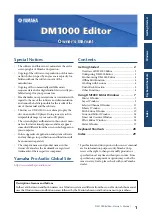
Appendix A: Glossary
A-7
Hub.
1. A multiport repeater for connecting several network segments together; this term is
usually associated with 10baseT networks. 2. A sophisticated network device consisting of a
chassis plus several plug-in boards, including bridges, routers, 10baseT hubs, and other devices.
.
IEEE.
I
nternational
E
lectronics and
E
lectrical
E
ngineers. A standards body that controls the
specifications for Ethernet and other networking-related standards, as well as many other electri-
cal and electronics standards.
IETF.
I
nternet
E
ngineering
T
ask
F
orce. The group that defines the de facto IEEE standards for
TCP/IP.
IP. I
nternet
P
rotocol. IP is the method or protocol by which data is sent from one computer to
another on the Internet. IP provides for the transmission of data (“datagrams”) from sources to
destinations, where sources and destinations are host computers identified by fixed length ad-
dresses. The Internet protocol also provides for fragmentation and reassembly of long data-
grams, if necessary, for transmission through ‘small packet’ networks.
IP Address.
All machines on an Internet network must have a unique IP address. An IP ad-
dress is a 32-bit number broken up into 4 bytes (each 8 bits in size) that identifies each sender or
receiver of information that is sent in packets across the Internet. The number is represented as a
decimal number with a period or dot (“.”) separating each of the 4 bytes. This is sometimes
known as the dot address and, more technically, as dotted quad notation for example:
196.168.0.101. In the decimal notation each of the four numbers can contain a value between 0
and 255.
An IP address has two parts, a network and host portion. The network portion is the identifier of
a particular network on the Internet and the host portion is used as a unique identifier of the par-
ticular device (which can be a server or a workstation) within that network.
IPDS. I
ntelligent
P
rinter
D
ata
S
tream. IPDS is an IBM proprietary page description language
used by IBM mainframes and minicomputers for complex printing. The IPDS architecture defines
the data stream used by print server programs and device drivers to manage all-points-
addressable page printing. IPDS data stream is interpreted and presented by microcode execut-
ing in printer hardware.
IPP.
I
nternet
P
rinting
P
rotocol, an emerging standard for printing across LANs and the Internet.
IPX.
I
nternet
P
acket
E
xchange. IPX is a datagram (connectionless) service protocol that allows
individual packets to be sent to and received from user processes. It does not support the con-
cept of a connection or reliable delivery. However, guaranteed services (like SPX) can be built
on top of IPX. IPX is used in situations where a guaranteed service is not required or where an
















































